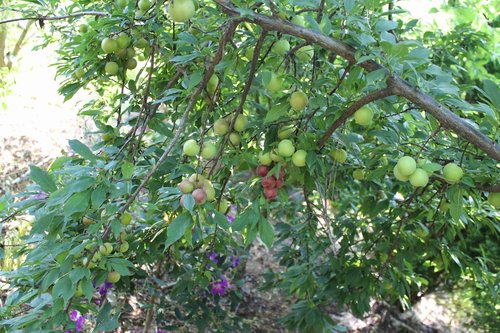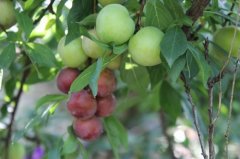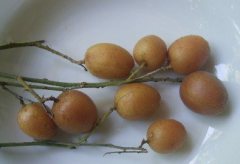The introduction of the cultivation and management methods of plum trees, the fertilization time and amount of plum trees.
Plums are a kind of fruit we often see. Do you know how they grow them? Is it the same as Hebrin's planting method?
1. Reproduction
Plum trees can be propagated by cuttings, striping, ramet and root cutting according to species or varieties, but grafting is generally used. Most of the plum trees in this province use peach or plum as rootstock for grafting propagation, the period of cutting propagation is from December to February, and the budding method is carried out from August to October.
two。 Planting
Plum trees are planted with annual seedlings, and the planting period is from defoliation in autumn to germination in spring. The distance between rows and plants is from 5x5 m to 7x7 m, depending on topography, soil, rootstock species and varieties. Li Shuduo has his own incompatibility and must be mixed with about 10% of pollinated trees.
3. Fertilizer application
The fertilization and timely irrigation of plum trees should be carried out according to the growth and fruiting habits and the soil and climatic conditions of various places.
(1) fertilization period
Fertilization after harvest applied gift fertilizer after plum harvest from April to June, and properly allocated according to tree age and tree potential to make the branches strong, leaves thickened, sprouting differentiation, and enhance the ability of overwintering.
The application of base fertilizer after defoliation was applied in winter dormancy from October to December. Deciduous fertilization is beneficial for plum trees to accumulate nutrients in winter for the normal growth of flower buds and leaf buds next year. Large amounts of organic fertilizer can also loosen the soil, aerate and improve soil physical properties.
Although basic fertilizer has been applied before flowering, spring flowering and leaf bud growth consume a large amount of nutrients, appropriate application of chemical fertilizer to promote neat flowering, improve fertilized eggs, and reduce flower and fruit drop.
In the early stage of young fruit expansion, topdressing young fruit expands rapidly after fruit setting, and new shoots begin to grow, which is the key period for plum trees to need a lot of nutrition. at this time, topdressing can promote fruit hypertrophy and create good conditions for flower bud differentiation.
In the later stage of fruit expansion, topdressing plus phosphorus and potassium fertilizer could improve the sugar content and quality of fruit.
(2) the amount of fertilizer applied
In general, the standard nitrogen fertilizer is about 1% of the yield, phosphorus fertilizer is nitrogen fertilizer, and potash fertilizer is about 20% more than nitrogen fertilizer.
4. Moisture management
Plum trees blossom, sprout, fruit and shoot grow rapidly in spring, if the soil is dry, it will cause falling flowers and fruits, and the growth of branches and leaves is small, so appropriate water supply is needed at this time. Sufficient rainfall in summer, foliar growth up to the highest degree, rain will have fruit cracking phenomenon, at this time should pay attention to drainage. Irrigation during drought in autumn and winter can make the soil store enough water, which is beneficial to root development and flower bud differentiation. The irrigation period can be divided into pre-anthesis, young fruit stage and overwintering water management.
5. Pruning
The purpose of pruning is to cultivate a strong and reasonable tree structure, so that the distribution of big branches is reasonable, there are many twigs without disorder, and make full use of the effective space of the crown. At present, natural happy shape or deformation is often used for trunk-shaped pruning, and the planted seedlings are cut off at 60ml 70cm from the ground and 25ml 30cm apart on the trunk. Three main branches with different directions, similar growth potential and an angle of not less than 45 degrees with the trunk are selected, and four auxiliary branches are formed from the main branches the following year. When the trunk shape changes, each section of three main branches is completed year by year. After reaching the fruiting age, the center of the central trunk is cut off to facilitate the development of short fruit branches and expand the fruiting area. If the tree is weak or there are too many short fruit branches, it should be properly pruned or renewed to restore the normal production tree potential.
Now that you know how to grow it, if you want to grow it, do it quickly!

- Prev

The main cultivated varieties of plums and their characteristics? Introduction of Salian Plum / Red Meat Plum / Yellow Meat Plum and other varieties
Do you like plums? Do you know what kinds of plums are on the market now? What is the fruit setting rate of plums? Let's have a look! The main cultivated varieties and their characteristics: also known as Shanlian plum, the tree is about 25 meters tall and has narrow leaves.
- Next

Is the seedless yellow fruit really seedless? What are the characteristics and advantages of seedless yellow fruit? does it taste good?
Many people have seeds in their seedless yellow fruits, and so did I at the time. This time I have four or five kinds of yellow fruits because of the abnormal climate last winter, only one tree blossomed and bear fruit, and it was later proved that it was really seedless. Last year, the same fruit tree had many seeds.
Related
- The first cup of black tea in spring, the flavor and history of tea gardens in Kenya, Africa
- The computer can not only choose potatoes, but also grow tea rice. AI will grow winter oolong tea champion.
- It is not only the inflated tea bitten by insects, but also engraved with the four seasons tea in Beipu.
- The Oriental Beauty Tea Festival in Zhuxian County takes the stage at the weekend to experience the plus-size feast of oil tea.
- & quot; Oriental Beauty Tea & Exploration of Emei in Hsinchu, the hometown of quot;
- The new variety of strawberry "Tainong 1" dessert is the first choice with mellow aroma. Crimson gorgeous
- History of Tea in Taiwan: from Wild Inner Mountain to Export Tea Garden
- Two types of Taiwan Oriental Beauty Black Tea won the British three-Star Award for Childhood Tea Xiang Zhang Jiaqi changed from pilot to champion tea maker.
- Banana species and varieties: the planting history of Taiwan Xianren banana and dwarf banana is long, is banana disease resistant?
- Coffee planting Technology: Qianjie Coffee from Seedling to harvesting

